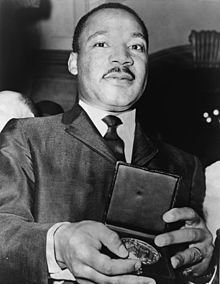User:DahliasAndRoses/sandbox
 | This is a user sandbox of DahliasAndRoses. A user sandbox is a subpage of the user's user page. It serves as a testing spot and page development space for the user and is not an encyclopedia article. |
DahliasAndRoses Sandbox

The African-American Civil Rights Movement/Plan[edit]
The African-American social movement, otherwise known as the 1960s Civil Rights Movement is known to be one of the most influential social movements of it's time. It's goal was to put an end to racial segregation and discrimination against black Americans and also protect their legal and human rights through nonviolent campaigning. The movement was lead by recognized figures such as Martin Luther King Jr., along with Bayard Rustin, Andrew Young,a New York Congressman, William Ryan, James Farmer, and John Lewis [1] . The proposed changes that would be suitable for the existing article is the inclusion of information such as the Jim Crow laws and how it influenced racial ideologies prior to the movement.
Jim Crow Laws[edit]

Jim Crow laws pertained to the separation of races in the Southern American States, also referred to as De jure segregation [2]. These laws legalized the the segregation between African American and Caucasian groups [3]. "The term Jim Crow can be traced all the way back to the 19th century as the name was derived from a character in a popular minstrel play performed in the United States during the 1820s" [4]. "The character possessed characteristics supporting stereotypes of blacks held by many whites in America" [5]. In 1896, the U.S. Supreme Court ruled in favor of the separation of facilities for African Americans and Caucasians in the case of Plessy v. Ferguson [6]. This legal decision mandated segregated equal facilities by race for both African Americans and Whites [7]. Following this, a series of laws that restricted the African American population's rights were enacted [8]."The so-called separate-but-equal doctrine was applied throughout the South and the District of Columbia" [9]."Jim Crow laws restricted the African American population's access to public services and facilities, such as schools, restaurants, hotels, and public transportation" [10]."Violence and practices such as lynching were often used as a means of social control, to punish those who violated the laws" [11]. In terms of education,"schools for African Americans had little access to equitable educational opportunities in elementary, secondary, and higher education institutions. Segregated schools received less funding, curricular opportunities were unequal, and African American teachers and principals were provided with less compensation—indeed, there were limited opportunities for them to be employed in the South. African American children were subjected to overcrowded classrooms, inadequate facilities, shorter school hours and calendars, unequal curricular resources, and poor physical recreational facilities" [12]. Along with public segregation, African Americans and Caucasians were prohibited from having social interaction in many aspects of private life as well [13]. "Many states even prohibited interracial marriage and sexual activity between white and non-white people" [14].
Impact of the American Civil Rights Movement[edit]

"The system of Jim Crow education was dismantled as a result of the civil rights movement, and the efforts of the National Association for the Advancement of Colored People (NAACP) legal campaign against segregated education. This culminated with the Brown vs. Board of Education, Topeka. Kansas, decision on May 17, 1954, declaring that separate education was inherently unequal. Without African Americans' persistence to develop schools beyond the principles embodied in Jim Crow, there would not have been a civil rights movement. African American schools, though segregated, served as a bulwark against the structure of Jim Crow" [15]. Jim Crow laws officially began to disintegrate after World War II. Legal initiatives such as the Civil Rights Act of 1964, the Voting Rights Act of 1965, and the Fair Housing Act of 1968 finally offered some legal remedy to the discriminatory practices of the Jim Crow laws" [16].
DahliasAndRoses (talk) 05:19, 9 April 2015 (UTC)Kishale Moore
References[edit]
<references>
- Jim Crow. (2010). In Andrew W. Robertson (Ed.), Encyclopedia of U.S. Political History. (pp. 1407-1413). Washington, DC: CQ Press. doi: http://dx.doi.org.uproxy.library.dc-uoit.ca/10.4135/9781608712380.n384
- Jim crow laws. (2009). In L. Sullivan (Ed.), The SAGE glossary of the social and behavioral sciences. (p. 276). Thousand Oaks, CA: SAGE Publications, Inc. doi: http://dx.doi.org.uproxy.library.dc-uoit.ca/10.4135/9781412972024.n1386
- ^ African-American Civil Rights Movement (1954–68)
- ^ Jim Crow. (2011). In George Thomas Kurian (Ed.), The Encyclopedia of Political Science. (pp. 857-858). Washington, DC: CQ Press. doi: http://dx.doi.org.uproxy.library.dc-uoit.ca/10.4135/9781608712434.n821
- ^ Jim crow laws. (2009). In L. Sullivan (Ed.), The SAGE glossary of the social and behavioral sciences. (p. 276). Thousand Oaks, CA: SAGE Publications, Inc. doi: http://dx.doi.org.uproxy.library.dc-uoit.ca/10.4135/9781412972024.n1386
- ^ Jim Crow. (2011). In George Thomas Kurian (Ed.), The Encyclopedia of Political Science. (pp. 857-858). Washington, DC: CQ Press. doi: http://dx.doi.org.uproxy.library.dc-uoit.ca/10.4135/9781608712434.n821
- ^ Jim Crow. (2011). In George Thomas Kurian (Ed.), The Encyclopedia of Political Science. (pp. 857-858). Washington, DC: CQ Press. doi: http://dx.doi.org.uproxy.library.dc-uoit.ca/10.4135/9781608712434.n821
- ^ Jim crow laws. (2009). In L. Sullivan (Ed.), The SAGE glossary of the social and behavioral sciences. (p. 276). Thousand Oaks, CA: SAGE Publications, Inc. doi: http://dx.doi.org.uproxy.library.dc-uoit.ca/10.4135/9781412972024.n1386
- ^ Ward Randolph, A. (2010). Jim Crow. In K. Lomotey (Ed.), Encyclopedia of African American education. (pp. 365-368). Thousand Oaks, CA: SAGE Publications, Inc. doi: http://dx.doi.org.uproxy.library.dc-uoit.ca/10.4135/9781412971966.n134
- ^ Jim crow laws. (2009). In L. Sullivan (Ed.), The SAGE glossary of the social and behavioral sciences. (p. 276). Thousand Oaks, CA: SAGE Publications, Inc. doi: http://dx.doi.org.uproxy.library.dc-uoit.ca/10.4135/9781412972024.n1386
- ^ Ward Randolph, A. (2010). Jim Crow. In K. Lomotey (Ed.), Encyclopedia of African American education. (pp. 365-368). Thousand Oaks, CA: SAGE Publications, Inc. doi: http://dx.doi.org.uproxy.library.dc-uoit.ca/10.4135/9781412971966.n134
- ^ Jim crow laws. (2009). In L. Sullivan (Ed.), The SAGE glossary of the social and behavioral sciences. (p. 276). Thousand Oaks, CA: SAGE Publications, Inc. doi: http://dx.doi.org.uproxy.library.dc-uoit.ca/10.4135/9781412972024.n1386
- ^ Jim crow laws. (2009). In L. Sullivan (Ed.), The SAGE glossary of the social and behavioral sciences. (p. 276). Thousand Oaks, CA: SAGE Publications, Inc. doi: http://dx.doi.org.uproxy.library.dc-uoit.ca/10.4135/9781412972024.n1386
- ^ Ward Randolph, A. (2010). Jim Crow. In K. Lomotey (Ed.), Encyclopedia of African American education. (pp. 365-368). Thousand Oaks, CA: SAGE Publications, Inc. doi: http://dx.doi.org.uproxy.library.dc-uoit.ca/10.4135/9781412971966.n134
- ^ Jim Crow. (2011). In George Thomas Kurian (Ed.), The Encyclopedia of Political Science. (pp. 857-858). Washington, DC: CQ Press. doi: http://dx.doi.org.uproxy.library.dc-uoit.ca/10.4135/9781608712434.n821
- ^ Jim Crow. (2011). In George Thomas Kurian (Ed.), The Encyclopedia of Political Science. (pp. 857-858). Washington, DC: CQ Press. doi: http://dx.doi.org.uproxy.library.dc-uoit.ca/10.4135/9781608712434.n821
- ^ Ward Randolph, A. (2010). Jim Crow. In K. Lomotey (Ed.), Encyclopedia of African American education. (pp. 365-368). Thousand Oaks, CA: SAGE Publications, Inc. doi: http://dx.doi.org.uproxy.library.dc-uoit.ca/10.4135/9781412971966.n134
- ^ Jim crow laws. (2009). In L. Sullivan (Ed.), The SAGE glossary of the social and behavioral sciences. (p. 276). Thousand Oaks, CA: SAGE Publications, Inc. doi: http://dx.doi.org.uproxy.library.dc-uoit.ca/10.4135/9781412972024.n1386
- ^ Ward Randolph, A. (2010). Jim Crow. In K. Lomotey (Ed.), Encyclopedia of African American education. (pp. 365-368). Thousand Oaks, CA: SAGE Publications, Inc. doi: [1]
